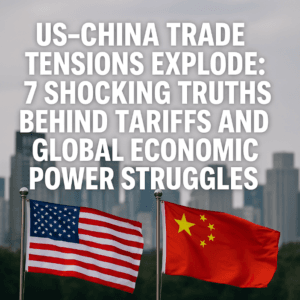US-China Trade Tensions Explode: 7 Shocking Truths Behind Tariffs and Global Economic Power Struggles
The US has escalated tariffs on Chinese goods to 145%, citing trade deficits and unfair practices, but China attributes the imbalance to structural flaws in the US economy, such as low savings and high consumption, alongside natural market advantages. Beijing emphasizes that bilateral benefits are balanced when services trade and multinational profits are considered, noting the US’s $26.57 billion services surplus and $490 billion revenue from American firms in China.
Critics argue the US’s unilateral Section 301 tariffs undermine WTO principles, evidenced by a 2020 ruling against these measures, now stalled due to a paralyzed Appellate Body. India echoes concerns, highlighting how tariff assessments often ignore services, where Western nations dominate. The standoff reflects a broader clash over defining trade fairness, with experts urging holistic metrics and revived multilateral frameworks to address systemic issues and prevent global trade fragmentation.
The path forward hinges on balancing mutual dependencies and rethinking narrow goods-focused narratives.

US-China Trade Tensions Explode: 7 Shocking Truths Behind Tariffs and Global Economic Power Struggles
The recent escalation of US tariffs on Chinese goods to 145% has reignited debates over trade imbalances and economic practices. While the US justifies these measures as a response to persistent trade deficits and alleged unfair practices, China counters that the imbalance stems from structural flaws in the US economy and global market dynamics—not deliberate policy. This clash underscores deeper fissures in international trade governance and how nations measure economic success.
China’s Defense: Structural Flaws and Comparative Advantage
China’s white paper argues that the US trade deficit is a byproduct of its own economic structure. The US, with its high consumption rates and low savings, relies heavily on imports to meet consumer demand. Meanwhile, China’s manufacturing prowess, driven by labor and cost advantages, positions it as a global supplier—a natural outcome of comparative advantage. Beijing emphasizes that labeling this imbalance as “unfair” overlooks the foundational principles of international trade, where specialization fuels efficiency.
The Overlooked Metrics: Services and Multinational Profits
Trade deficits often spotlight goods, but China urges a broader lens. In 2023, the US recorded a $26.57 billion surplus in services trade, highlighting its strength in sectors like finance, education, and intellectual property. Additionally, US multinationals operating in China generated $490.52 billion in sales in 2022, dwarfing the $78.64 billion earned by Chinese firms in the US. This $411.88 billion gap reveals how US companies profit significantly from China’s market, a dimension absent from goods trade data.
“Judging balance purely on goods trade is like evaluating a book by its cover,” notes an Indian trade expert, echoing concerns that Western nations often sideline services—a domain where they dominate—in trade assessments.
The Unilateralism Debate: Section 301 and WTO Paralysis
The US’s use of Section 301 tariffs, which bypass multilateral frameworks, has drawn sharp criticism. China condemns these measures as economic hegemony, pointing to a 2020 WTO ruling that deemed the tariffs GATT-violations. However, the US’s appeal remains in limbo due to its own blockage of the Appellate Body’s appointments since 2019, effectively crippling the WTO’s dispute system. This stalemate reflects a troubling trend: powerful nations undermining the very institutions designed to ensure fair play.
Ripple Effects: Global Trade and India’s Perspective
The tariff dispute carries implications beyond bilateral relations. India, facing similar US tariffs, highlights the exclusion of services in trade calculations—a sector where developing nations lag. This asymmetry fuels calls for holistic assessments that account for services and investment flows, challenging the dominance of goods-centric metrics.
The Path Ahead: Multilateralism or Fragmentation?
The US-China standoff tests the resilience of global trade systems. While tariffs may offer short-term political wins, they risk inflating consumer prices, disrupting supply chains, and provoking retaliation. Historians draw parallels to the 2018–2020 trade war, which left both economies bruised.
Experts argue that lasting solutions require addressing structural issues—like US savings gaps and China’s market reforms—while revitalizing multilateral frameworks. “Trade isn’t a zero-sum game,” asserts economist Linda Yueh. “Balanced narratives must consider capital flows, corporate profits, and mutual dependencies.”
Conclusion: Beyond the Headlines
The US-China tariff conflict is more than a spat over numbers; it’s a clash over how economic success is defined. By fixating on goods deficits, policymakers risk overlooking the invisible threads binding global economies—services, investments, and shared growth. As the WTO languishes in dysfunction, the world watches whether these giants will chart a collaborative path or deepen a fractured trade landscape. The answer will shape not just their futures, but the stability of global commerce itself.
You must be logged in to post a comment.